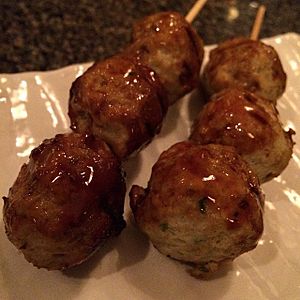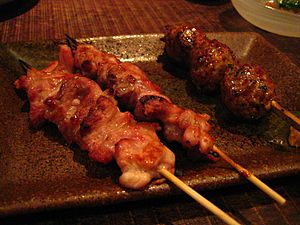Tsukune facts for kids
Tsukune (つくね、捏、捏ね) is a popular Japanese chicken meatball. It's often cooked in a special way called yakitori style, which means it's grilled on a stick. You can also find tsukune fried, baked, or boiled. Sometimes, it's covered in a sweet soy glaze called tare. This tare sauce is a bit like teriyaki sauce, but it's its own special flavor!
What is Tsukune?
Tsukune is made from ground meat, usually chicken. But it can also be made from other meats like beef, pork, or even fish. To make it, cooks mix in special ingredients called thickeners. These help the meat stick together. Then, the mixture is shaped into small balls or patties. Sometimes, it's put onto a skewer, which is a thin stick.
Tsukune can also be a fish meatball. When it's added to hot soup, it's called tsumire-jiru (つみれ汁). This is a delicious fish ball soup. Another way to enjoy tsukune is in a dish called tsukune nabe (つくね鍋). This is a Japanese hot pot dish, where you cook food right at your table! Different parts of Japan have their own special ways to make it.
Long ago, people used a special grinding bowl called a suribachi (すり鉢) to grind fish for tsukune. Today, most people use blenders, which makes it much easier!
How Tsukune is Made
To make tsukune, the meat is first mashed or minced very finely. Then, ingredients like egg, crushed yam, or bread crumbs are added to make it thick. Seasonings are also mixed in, such as ground ginger, salt, and soy sauce. After everything is mixed, the cooks shape the mixture into meatballs or long meat sticks.
Sometimes, finely chopped vegetables are added to the meat. This gives the tsukune extra flavor and texture. Common vegetables include Welsh onion and red perilla. Some recipes even add small pieces of chicken cartilage. This makes the tsukune extra crunchy, which many people love!
Tsukune is also a common ingredient in oden (おでん). Oden is a Japanese stew that has many different ingredients cooked in a light broth called dashi (出汁).
Different Ways to Cook Tsukune
There are many yummy ways to cook tsukune:
- Boiled: It can be boiled in a dish called Nabemono (鍋物), which is a meal cooked right at your table.
- Grilled: This is called Yakimono (焼き物). Tsukune is often grilled over fire or charcoal on bamboo skewers. You can also cook it without skewers in a frying pan.
- Fried: You can deep-fry tsukune. This is known as Agemono (揚げ物).
- Stewed: Tsukune can be stewed with vegetables and herbs. This type of dish is called Tsuyumono (汁物) or Dango-jiru (団子汁).
See also
 In Spanish: Tsukune para niños
In Spanish: Tsukune para niños



